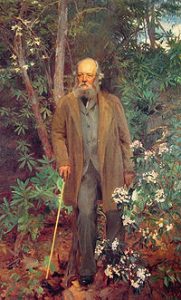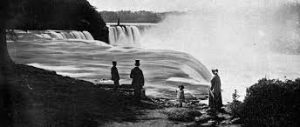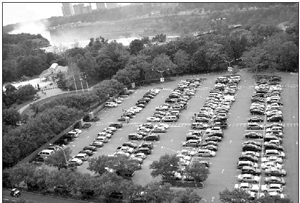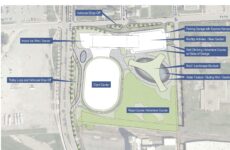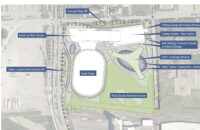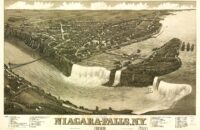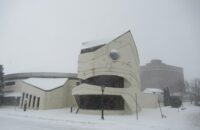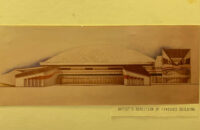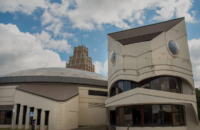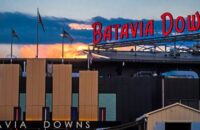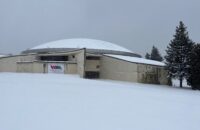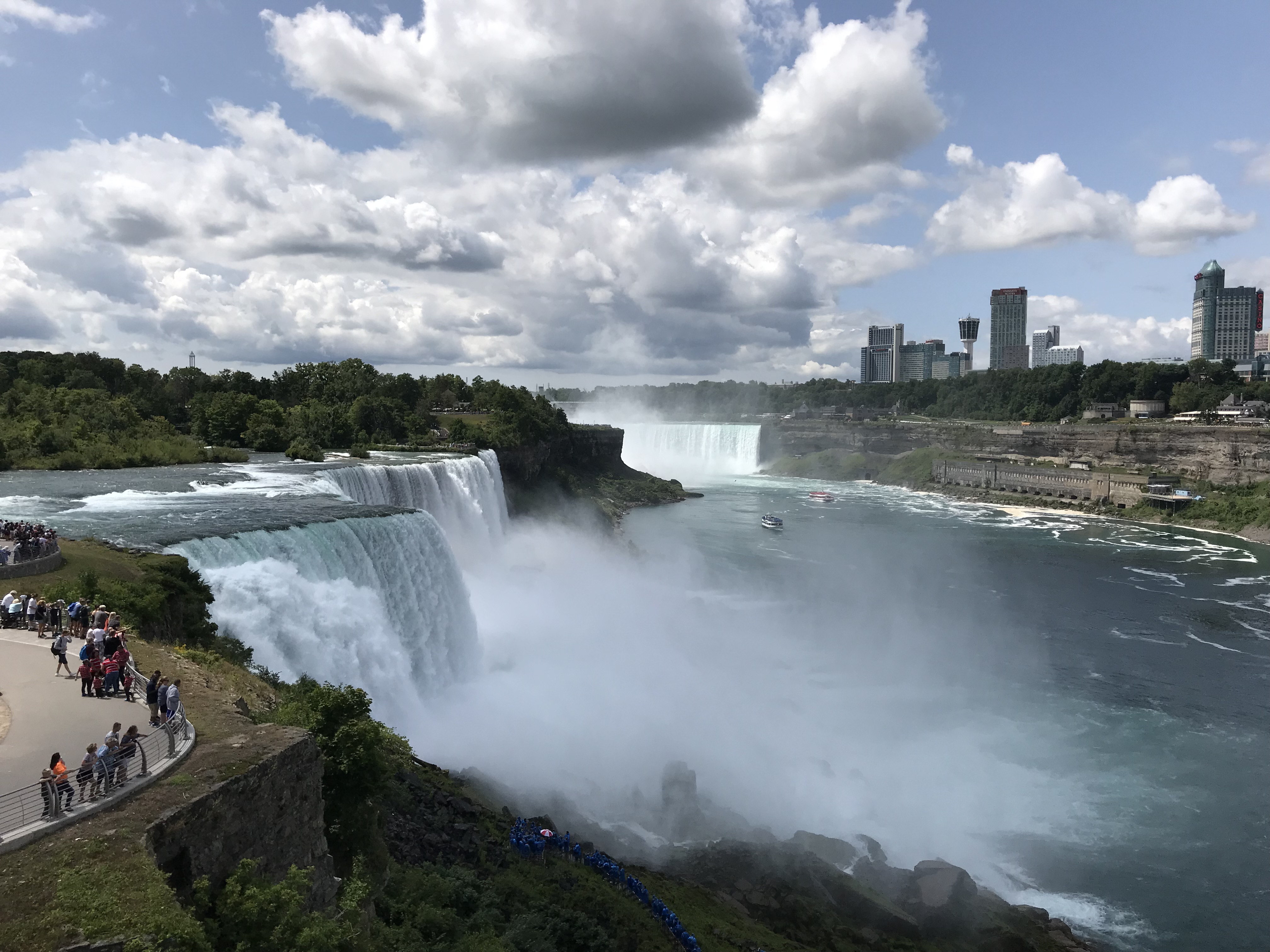The Empire State Development Corp.will be issuing a request for proposals to build “greater outdoor activities” on Goat Island, according to Gov. Andrew Cuomo.
Build on Goat Island.
“[T]hat will boost tourism and give people an international destination to visit,” Gov. Cuomo said.
Among the buildings Cuomo wants to build is a lodge (a hotel).
“On Goat Island, we will create a year-round destination for tourism and build a world-class lodge with sweeping views of the Niagara River,” said Cuomo.
As he waxed poetic, invoking the name of Olmsted, speaking of reclaimed acres and preserving rich ecology, and building a hotel on Goat Island and maybe zip Lines and tree climbing attractions, and back to “the days of Olmsted,” the governor basically said.
“When you look across the river, you see Canada has more activities… We need to correct that, and we’re going to do it in Niagara Falls,’ he said.
And all of this would be proper, if they would just stop using the name Olmsted. State Parks still advertise Niagara Falls State Park as an Olmsted Park.
It is not.
Frederick Law Olmsted was the designer of Central Park, Yosemite and the original Niagara Reservation.
But when the Niagara Falls State Park says, “We’re an Olmsted Park,” it’s not accurate or fair.
It’s like when people in Niagara Falls think they get their power from the falls of Niagara. It’s not accurate and deeply unfair.
In the 1870s, the village of Niagara Falls planned to develop land – almost to the brink of the American Falls – subdivided as small building lots for residential homes.
Olmsted was alarmed and lobbied the state legislature to stop the plan and got them to approve the restoration and preservation of the land around the falls, including Goat Island, which at one time was planned for a prison.
In 1886, the “Reservation of Niagara” became the first state park in the United States, and the state adopted Olmsted’s 100-page plan for stewardship of the park.
Olmsted’s plan can be reduced to four ‘cardinal’ points:
- Keep the park all green — with indigenous flora.
- Absolutely no commercial enterprises in the park.
- No man-made gardens, fountains or statues.
- No parking (at that time horse and carriage) except for “a few shady harbors.”
At first, the park operated as an Olmsted park. And the region flourished.
We had hydropower and tourism.
We were called “The Power City.”
In 1956, we had the most abundant, inexpensive electricity in the nation.
In 1957, Robert Moses persuaded the city of Niagara Falls to surrender control of its hydropower to Albany. Moses claimed his New York Power Authority would preserve the city’s prosperity better than us having greedy local control of the world’s greatest hydropower. They were a public benefit corporation, after all.
From having the most abundant and inexpensive electricity, after 60 years of Albany control Niagara Falls residents now pay among the highest electrical rates in America. And instead of having use of our local power, Albany diverts it to other areas, particularly New York City.
Meanwhile, as stewards of the “Olmsted Park,” Albany changed the name from the “State Reservation of Niagara” to the “Niagara Falls State Park.” Other changes followed.
“It may be safely assumed,” Olmsted wrote, “that no improvement that the State can make will increase the astonishing qualities of Niagara.”
He wanted a pristine park for “pensive contemplation.” He said, “In this respect, Niagara deserves to rank among the great treasures of the world.”
Among the changes Albany accomplished was to reduce the flow of water going over Niagara Falls, diverting more than 60 percent of the water approaching the Falls through underground turbines to generate electricity for New York City and eight other states.
Today, Niagara Falls is a tame and timid waterfalls compared to what once was. And the city bearing its name is also tame and timid compared to what it once was.
Olmsted’s park plan called the prohibition of restaurants and stores “a cardinal necessity (for) success.” He wrote, “If it were a commercial undertaking into which the State was entering, in competition with the people of the village of Niagara, it cannot be questioned that the restaurant could be made profitable.”
Today, restaurants and stores in the park compete aggressively with city businesses.
And of course, scattered all over the park are statues and man-made gardens.
Olmsted planned that there would be no land set aside for parking, except a few “shady harbors” for brief stopping, “because at best many trees must be destroyed.”
By 1987, Albany had clear-cut acres of trees for parking, including a giant lot near the Maid of the Mist attraction. Ironic: Olmsted snatched that land away from a housing development. Now it’s a parking lot.
The owner of the Maid of the Mist boat ride, James Glynn, is said to have had a hand in persuading park officials that, if they made an expansive parking lot near his attraction, both he and the park would make more money.
From this point onward, the park went from Olmsted to a parking, souvenir and restaurant business – with a waterfall attraction – for the benefit of Albany, Glynn and the food and beverage concessionaire Delaware North.
Over time, helpful state park officials gave Glynn one sweetheart deal after another including, amazingly, in 2002, a souvenir store. They gave him the pig’s share of the profits on the state-owned Observation Tower, and threw in an unheard-of 40-year lease on his boat ride – all done in secret. Best of all, instead of Glynn paying rent, park officials signed a secret lease where they pay Glynn, rather than the other way around.
And as Glynn got rich, as the park changed to a business enterprise, they entered increasingly in competition with the city.
Their plan was simple: Route all tourists along the state-owned parkway, ironically named after the man who stole the local hydropower, Robert Moses. Get them into the state lot, diverting them from parking in the city. In the park, tourists pay $10 for parking. Albany gets that. Then to the Maid of the Mist: $20 that goes to Glynn. Then exit the boat tour, through Glynn’s souvenir store. Glynn again. You eat at any one of the restaurants in the park from upscale to fast food and buy gifts in one of the Delaware North stores.
Because the park is basically small and has limited parking, in the summertime the only pensive contemplation is devoted to how to get them out fast after they spend every tourist dollar in the park alone.
And as far as the Olmsted plan is concerned, now we’re getting a lodge too, Robert Moses, or was it the governor, just said.

